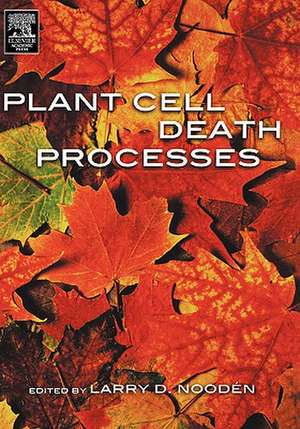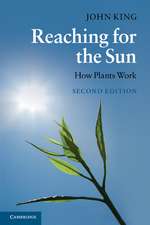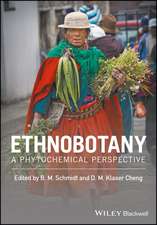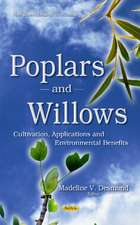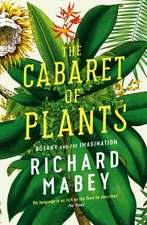Plant Cell Death Processes
Editat de Larry D. Noodenen Limba Engleză Hardback – 9 dec 2003
Summaries of the myriad aspects of cell death in plantsDiscussion of the broadest implications of these disparite resultsA unification of fields where there has been no cross talkEnables easy entry into diverse but related lines of research
Preț: 781.64 lei
Preț vechi: 1070.74 lei
-27% Nou
Puncte Express: 1172
Preț estimativ în valută:
149.60€ • 154.18$ • 126.30£
149.60€ • 154.18$ • 126.30£
Carte tipărită la comandă
Livrare economică 01-15 martie
Preluare comenzi: 021 569.72.76
Specificații
ISBN-13: 9780125209151
ISBN-10: 0125209150
Pagini: 392
Ilustrații: 1
Dimensiuni: 178 x 254 x 24 mm
Greutate: 0.94 kg
Ediția:New.
Editura: ELSEVIER SCIENCE
ISBN-10: 0125209150
Pagini: 392
Ilustrații: 1
Dimensiuni: 178 x 254 x 24 mm
Greutate: 0.94 kg
Ediția:New.
Editura: ELSEVIER SCIENCE
Public țintă
Advanced undergraduate and graduate students, faculty and researchers in plant science, especially those studying development, growth, physiology, pathology and related disciplines; also academic libraries that support these programs.Cuprins
Introduction
Death and Cell Differentiation
Disease, Mechanisms, and Molecular Markers
Gene Expression during Senescence
Genes that Alter Senescence
Senescence and Genetic Engineering
Proteolysis
Ethylene Signaling
Jasmonates - Biosynthesis, Stress Responses and Development
Programmed Cell Death and Related Processes
Photosynthesis and Chloroplast Breakdown
How Leaves Turn
Free Radicals and Oxidative Stress
Nutrient Resorption
Whole Plant Senescence
Autumnal and Trees
Top Senescence in Perennials
Phototoxicity
Ultraviolet Effects
Effects of Airborne Pollutants
Physiology of Flower Senescence
Postharvest Senescence of Vegetables
Evolution and Demography of Whole Plant Senescence
Flower Longevity
Leaf Senescence
Light and Senescence
Death and Cell Differentiation
Disease, Mechanisms, and Molecular Markers
Gene Expression during Senescence
Genes that Alter Senescence
Senescence and Genetic Engineering
Proteolysis
Ethylene Signaling
Jasmonates - Biosynthesis, Stress Responses and Development
Programmed Cell Death and Related Processes
Photosynthesis and Chloroplast Breakdown
How Leaves Turn
Free Radicals and Oxidative Stress
Nutrient Resorption
Whole Plant Senescence
Autumnal and Trees
Top Senescence in Perennials
Phototoxicity
Ultraviolet Effects
Effects of Airborne Pollutants
Physiology of Flower Senescence
Postharvest Senescence of Vegetables
Evolution and Demography of Whole Plant Senescence
Flower Longevity
Leaf Senescence
Light and Senescence
Recenzii
Throughout 26 chapters Plant Cell Death Processes discusses all essential topics of plant senescence from molecular approaches to ecological and evolutionary considerations. An introductory chapter together with comparative cell death and integrative whole plant senescence chapters provide updated perspectives which will be appreciated by both specialized and general interest readers.
Going into basic mechanisms, chapters provide a full account of the different senescence-related processes with special emphasis on recent molecular and genetic approaches connecting pioneering senescence investigations, programmed cell death (PCD) in plants and animals and responses to biotic and abiotic stresses. Far from a descriptive approach, introductory and ecological chapters provide excellent complements to the integrative explanations in the chapters devoted to specific processes or organs. Triggering factors, cause-effect sequences of processes an the ecological-evolutionary fitness meaning of senescence are the key questions in the field. They are competently treated through specific perspectives in the different chapters, avoiding simplifications and showing their complexity and molecular relations with other processes previously considered outside of the senescence field. In my opinion, Plant Cell Death Processes will be an obligate reference book for those investigating in plant senescence and in several fields sharing molecular processes with senescence.
-Prof. Bartolomé Sabater, Universidad de Alcalá, Madrid, Spain
Going into basic mechanisms, chapters provide a full account of the different senescence-related processes with special emphasis on recent molecular and genetic approaches connecting pioneering senescence investigations, programmed cell death (PCD) in plants and animals and responses to biotic and abiotic stresses. Far from a descriptive approach, introductory and ecological chapters provide excellent complements to the integrative explanations in the chapters devoted to specific processes or organs. Triggering factors, cause-effect sequences of processes an the ecological-evolutionary fitness meaning of senescence are the key questions in the field. They are competently treated through specific perspectives in the different chapters, avoiding simplifications and showing their complexity and molecular relations with other processes previously considered outside of the senescence field. In my opinion, Plant Cell Death Processes will be an obligate reference book for those investigating in plant senescence and in several fields sharing molecular processes with senescence.
-Prof. Bartolomé Sabater, Universidad de Alcalá, Madrid, Spain
